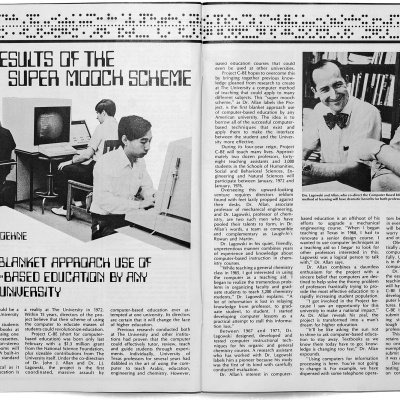Inside a Plan at UT to Capture and Store Carbon—Forever

On a cold, sunny December day in Austin, a cadre of UT researchers trekked out to the Brackenridge Field Laboratory, an 82-acre biological research site on Lake Austin Boulevard. In these fields are a few dozen research wells ranging from one to
20 feet deep. The researchers injected liquid carbon dioxide from small pressurized bottles into the wells, and waited to see what would happen.
This experiment was just one small part of a campus-wide, decades-long effort at UT to master carbon capture and storage (CCS). The idea is that companies and governments can capture CO2 before it exits the smokestack of an industrial facility, transport it away from the site, and pump it underground into an aquifer or geological formation that will hold it forever. If executed correctly, CCS would lessen the amount of carbon reaching the atmosphere and stave off climate change.
It may sound ambitious, but it’s no pipe dream. The technology to do it is here, thanks in no small part to various teams of UT geologists, chemists, and petroleum engineers who have been working on CCS for two decades. CCS’s proponents eye it as an ailment to our carbon-addled society, allowing us to keep gas- and coal-fired plants online as we wean off our high levels of emissions, decarbonize, and stabilize the climate.
“Nearly anyone who has turned on a power source today has benefitted from [fossil fuels],” says Sue Hovorka, MA ’81, PhD ’90, a senior research scientist at UT’s Bureau of Economic Geology. Fossil fuels form the lion’s share of energy production. The world is still heavily invested in carbon-intensive industries. Hovorka says that could change. “Many people have become aware that fossil fuels, as well as being part of the solution, are part of the problem,” she says. In this light, CCS is seen as a pragmatic compromise: The benefits of petrochemicals can be retained while mitigating the costs.
As a geologist, Hovorka’s expertise is on the storage side, also known as carbon sequestration. She studies how to make storage safe and effective. Hovorka and her team work with geological formations in Texas, and recently, the seafloor of the Texas Gulf Coast. The latter has a real advantage: It’s the edge of the continent, it’s shallow, the sediment can accept large volumes of CO2, and the area belongs to the state. “And the subsurface is a porous medium. It’s a bit like a sponge: What goes in doesn’t come out,” Hovorka says. Finding the right medium is a crucial step to ensure that after the CO2 is bottled up and pumped under, it stays there.
Hovorka and her team’s work is complemented by that of Gary Rochelle, a UT chemical engineering professor. Rochelle’s expertise is in amine scrubbing, a technological method that separates the CO2 from the flue gas of coal- and gas-fired power plants. Amine scrubbing is the most effective CCS technology, Rochelle says. As one of the foremost experts on the technological capture side, Rochelle says that we have the requisite technical know-how to put CCS on power plants all across the world.

But there’s a catch: the hefty price tag. Capturing carbon is expensive, to the tune of about $1 billion per plant, Rochelle estimates. Capture systems also reduce a plant’s energy output and efficiency. Widespread adoption is “not going to happen just because we keep working on the technology,” Rochelle says.
In the past, critics say, CCS has promised much and delivered little. Some projects have hemorrhaged money; others were scuttled due to cost overruns and production delays. Neither side of the political aisle is exceptionally thrilled with it. Given the substantial price tag, few in the industry have opted to go for it.
Regardless, there are some promising signs on the horizon for CCS. In April 2017, NRG Energy cut the ribbon on its Petra Nova project near Houston, the world’s largest post-combustion carbon capture system. UT’s involvement was instrumental, says David Greeson, BBA ’80, VP of development at NRG. UT petroleum engineering professor Larry Lake identified spent oil fields that could handle CO2 injections. Rochelle’s work “was invaluable to the whole industry and everybody that’s got an amine scrubbing carbon capture technology” has benefited, Greeson says. And Hovorka’s team is actively involved in an ongoing basis monitoring the CO2 storage.
The right incentives, like a U.S. Department of Energy grant, Texas tax credits, and a low-interest loan from the Japanese government, coupled with the geography, resources, and university’s assistance, made Petra Nova feasible, say Greeson and NRG Communications Director David Knox, BA, BS ’79. The company’s down-range goal is to “start our coal fleet down a path of decarbonizing,” Greeson says. But with the current prices of electricity, oil, and renewables, and lacking further incentives, it would be economically indefensible, he says, to build another Petra Nova.
Though the technology at Petra Nova has yet to scale, there is ample interest in it, from the oilfields of Texas to the corridors of Washington, D.C. Corporate interests and nation-states alike are bankrolling research. Members of Hovorka’s team have hosted Mongolians in Midland and Norweigans on the Gulf Coast. NRG is in talks with other coal-fired plant owners about lessons it has learned from Petra Nova. A generous CCS tax credit was tucked into February’s continuing budget resolution and President Trump praised clean coal in his State of the Union address.
In the coming months, fieldwork will continue at Brackenridge. Geologists will scour the Texas landscape for new storage sites. Engineers will test how different solvents absorb carbon. Whether UT’s CCS work is mapped onto existing and new power plants is less clear. “It’s not inexpensive, but we can do it,” Rochelle says. “If we’re willing to recognize this as a problem and say that we need to do something about it, it can happen.”






